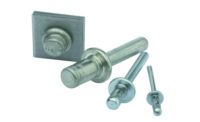Joining dissimilar materials has long posed a challenge for design engineers. However, by combining different technologies such as adhesive bonding and mechanical fasteners, manufacturers can create strong, rigid assemblies that incorporate the best of both worlds.
Hybrid joining comes in many different forms, but is typically defined as "the combination of two or more joining techniques to produce joints with properties additional to those obtained from a single technique," says Ewen Kellar, principal project leader of the polymers group at The Welding Institute (TWI, Cambridge, England). "The most common types of hybrid joints are used for joining sheet materials and involve an adhesive in conjunction with a single-point joint technique, such as a rivet."
According to Kellar, techniques such as riv-bonding have been successfully used to join aluminum sheets in aerospace and automotive applications. Typically, an adhesive is applied to the surfaces to be joined prior to assembly. The parts are then joined with rivets. Compared to joints made only with rivets, riv-bonding offers benefits such as:
- Continuous, leak-tight joints.
- Higher-strength joints.
- Increased joint stiffness.
- Improved peel and impact resistance, because crack growth away from the joint is arrested by the adhesive bond.
"Although purists may argue that a high quality, all-bonded structure is aesthetically and structurally superior, or that a bolted structure is the simplest and most effective solution, both approaches have their shortcomings," Kellar says. "The hybrid joint offers the benefits of both systems in that the number of fasteners can be reduced significantly, thereby reducing the effect of hole damage and increasing the fatigue resistance of the structure....The fasteners that remain can act as a backup mechanism in the event of significant adhesive failure."
When riv-bonding, the presence of adhesive does not change the basic setting operation. But, it may influence the setting parameters and the load-displacement characteristics. Adhesives can also have a lubricating effect on the riveting process, a variable that needs to be taken into account during rivet and die selection, says Michael LaPensee, vice president of applications and marketing at Henrob Corp. (Novi, MI).
To reduce cycle times and prevent contaminating riveting tools with adhesive, engineers at TWI have developed a new hybrid riveting process called AdhFAST. This system is unique in that components can be assembled dry, checked for tolerance and then injected with adhesive at the final stage.
"This ensures a simplified process with increased quality control, maximizing the benefits of hybrid joint technology," says Steve Westgate, technical specialist in TWI's laser and sheet processes group. "Adhesive dispensing can be metered, with minimal wastage, making the process cleaner, with resultant health, safety and economic benefits."
According to Westgate, the adhesive is injected into the joint through specially designed fasteners. The fasteners also incorporate a means of controlling the spacing between the top and bottom substrates.
"This gives greater control of bond-line thickness and, therefore, improved process reliability and joint quality," he says. "The AdhFAST fastener can be either in the form of a specially designed component or, in some cases, a standard commercial fastener to which some modification has been made."
As automakers in particular continue to experiment with lightweight materials, most observers predict that hybrid riveting applications will grow.
"Automobiles have historically been assembled using multiple spot welds and, in more recent years, self-piercing rivets," says LaPensee. "However, as the requirements for stiffer and quieter vehicles become more demanding, the use of adhesives is becoming more widespread."
LaPensee notes that adhesives alone typically have very poor peel strength, which compromises vehicle crash performance. "The solution is to use a hybrid riv-bonded joint where the adhesive is the primary joining mechanism providing the stiffness and noise, vibration and harshness characteristics," he says. "The rivets get a free ride, but become the primary joining mechanism during a crash event when the adhesive would normally peel."
In recent years, several European manufacturers have demonstrated that aluminum bodies assembled using riv-bonding technology can equal or exceed chassis stiffness requirements. Successful aluminum-intensive vehicles that use riv-bonding technology include the Audi A8, the BMW 5 Series and the Jaguar XJ.
"The new BMW 5 Series uses aluminum and steel from A pillar to A pillar," says Joe Butvin, director of sales and marketing at Bollhoff-Rivnut Inc. (Kendallville, IN). "[BMW uses] 600 self-piercing rivets to assemble the components and most have adhesive involved."
The Jaguar XJ features an aluminum-sheet-intensive monocoque construction. It is assembled using lightweight aluminum joined by self-piercing rivets and epoxy adhesive. Jaguar engineers claim they adopted state-of-the-art techniques from the aerospace industry.
"The XJ's body is 60 percent stiffer yet 40 percent lighter than before," says Mike Richardson, research manager at Jaguar Cars Ltd. (Coventry, England). "In the XJ8, that translates into an overall weight savings of almost 200 pounds."

